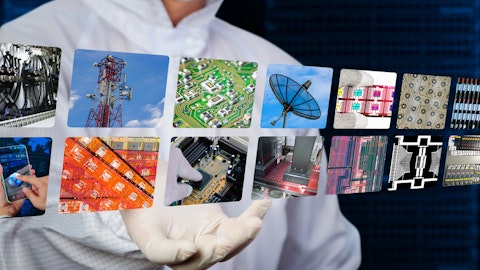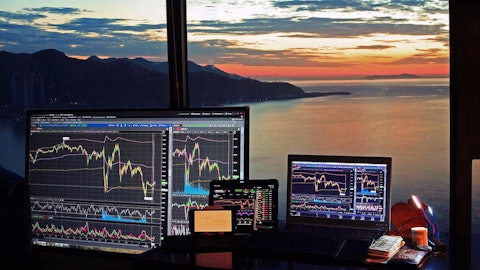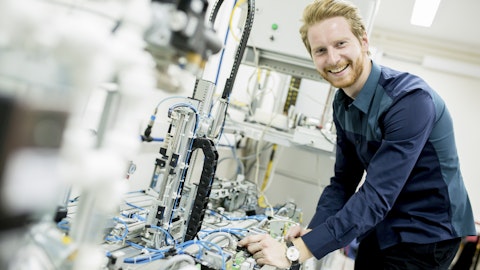Photronics, Inc. (NASDAQ:PLAB) Q4 2023 Earnings Call Transcript December 13, 2023
Photronics, Inc. beats earnings expectations. Reported EPS is $0.6, expectations were $0.53.
Operator: Good day and welcome to the Photronics Q4 FY ’23 Earnings Call. At this time all participants are in listen-only mode. Later we will conduct a question-and-answer session and instructions will be given at that time. As a reminder, this conference is being recorded Wednesday, December 13, 2023. I would now like to turn the conference over to Richelle Burr, Chief Administrative Officer.
Richelle Burr: Thank you, Michelle. Good morning, everyone. Welcome to our review of Photronics fiscal 2023 fourth quarter results. Joining me this morning are Frank Lee, our Chief Executive Officer; Chris Progler, our Chief Technology Officer; John Jordan, our Chief Financial Officer, and Eric Rivera, our Chief Accounting Officer and Corporate Controller. The press release that we issued earlier this morning, together with the presentation material that accompanies our remarks, are available on the Investor Relations section of our web page. Comments made by any participants on today’s call may include forward-looking statements that include such words as anticipate, believe, estimate, expect, forecast, and in our view. These forward-looking statements are based upon a number of risks, uncertainties, and other factors that are difficult to predict.
Actual results may differ materially from those expressed or implied, and we assume no obligation to update any forward-looking information. During the course of our discussion, we will refer to certain non-GAAP financial metrics. These numbers are useful for analysts, investors and management to evaluate ongoing performance. A reconciliation of these metrics to GAAP financial results is provided in our presentation materials. At this time, I will turn the call over to Frank.
Frank Lee: Thank you, Richelle, and good morning, everyone. The Photronics team had another outstanding year in 2023, and delivered record revenue for the 6th consecutive year. Over that six-year period, we have achieved a compound annual revenue growth rate of over 12%. For full 2023, revenue grow 8% year-over-year, while the photomask market overall was flat. And the semiconductor industry overall is expected to contract by up to 12%. The Photronics year-over-year revenue growth once again offers testimony to the tendency of design driven photomask demand to be less cyclical than the industry in general. Most recent indications from industry leaders and from our customers is that the current semiconductor cycle contraction should transition to the next phase of growth around the middle of next year.
Thus, if phase cycles and current observation can be considered indicators, photomask demand should resume a more robust growth phase during Photronics second to third fiscal quarters. Margin for the quarter and year were also outstanding. We achieved an operation margin of 28.5% for the first quarter and 28.4% for the full-year 2023, the best year in the history of the company. The combination of the following has continued to support the sustainability of this margin level. The high operation leverage, stable pricing from our long-term purchase agreement, our focus on delivering the best quality mask, and our driving for being the low-cost producer. As a result of the solid operation results and the contribution from below-the-line items, we earned in Q4 $0.72 per share on a GAAP basis and $0.60 per share on a non-GAAP basis.
Strong cash flow was generated in 2023, contributing to a stronger balance sheet and increasing our cash position with reducing debt. We continue to invest in growth position us to continue the past several years strong performance. To summarize, we achieved another record year in 2023, growing revenue in [flat] (ph) market. Our team performed well and our customers continue to trust us as their photomask partners. We are investing in high return projects and are positioned to continue to outgrow the market and create value for our shareholders. I’m proud of our accomplishment and excited about our future. And I would especially like to express my gratitude to the more than 1,800 employees that have worked hard to achieve these results. At this time, I will turn the call over to John to discuss the results further.
John Jordan: Thank you, Frank. Good morning, everyone. Our fourth quarter finalized another great year for Photronics. In my comments, I’ll first discuss the fourth quarter results, then the results for the full fiscal year. Fourth quarter revenue of $227.5 million increased 8% over fourth quarter of last year and 1% sequentially. Photronics fourth quarter always ends on October 31, which may add or subtract days to the standard 91-day 4-4-5 fiscal calendar. This year, fourth quarter was boosted by an extra two days in the quarter. It was our second highest quarterly revenue ever, only 1% off the record established in Q2 of fiscal year 2023. Our revenue into China in Q4 declined from 53% of total revenue in Q3 to 44% replaced by revenue with other customers.
It might be worthwhile to add some further color regarding the China business. Although we derive a good portion of revenue from China, as do others in the semiconductor and display industry, what makes the China business somewhat unique is that there is a significant number of new designs and fabs in China driving photomask demand. And since there is a much smaller captive market in China, the preponderance of the photomask production is being provided by merchant manufacturers like Photronics. The business by major category, IC revenue of $164.5 million in the fourth quarter was up 1% sequentially and 5% year-over-year. Our high-end revenue defined as IC masks using 28 nanometer and smaller technology drove the increase with 27% sequential growth, which more than offset the reduction in mainstream revenue.
High-end revenue was strong in foundry logic in both U.S. and Asia. The 9% decrease in mainstream revenue resulted in large part from lower delivery premiums due to somewhat moderated demand and more normalized lead times for those products. For the FPD product category fourth quarter FPD revenue was a record $63 million, up 3% sequentially, and 17% year-over-year, a 7% increase in high-end revenue, defined as LTPS, AMOLED and G10.5 large area masks, drove the increase from strong demand for AMOLED display masks used in mobile displays where we have technology leadership. The additional FPD production devoted to high-end mask production then resulted in 13% lower mainstream revenue. Gross margin was solid at 37.3%, although slightly lower due substantially to the decreased premiums for expedited delivery of the mainstream IC masks.

Operating expenses decreased somewhat and declined as a percentage of revenue to less than 9%, helping us achieve an operating margin of 28.5% in the quarter. GAAP net income in the quarter was $44.6 million or $0.72 per diluted share. Non-GAAP net income, which eliminates foreign currency effects primarily unrealized was $37.2 million or $0.60 a share. For reference, our reconciliation of GAAP to non-GAAP results is included in the press release and supplemental slides. For the year, total revenue of $892.1 million was 8% higher than the $824.5 million reported in fiscal year 2022, the 6th straight year of record revenues, as Frank mentioned, a compound annual growth rate of 12% over the last six years. Revenue in fiscal year 2023 was nearly double the revenue of fiscal year 2017, when we repositioned the business and initiated the targeted investments to address where we anticipated growth to be in the photomask space.
IC revenue for the year was a record and grew 9.8% as strong demand for mainstream masks for a good part of the year offset a slight decrease in high-end revenue, primarily in the U.S. Near-term, our investment will be primarily in IC capacity to continue outgrowing the market and take advantage of our market strength and close customer relationships. FPD revenue is also a record for the year, up 4%, with high-end growth consistently driven by AMOLED demand. We anticipate this trend to continue into fiscal 2024. Gross margins for the year were 37.7%, 200 basis points over the strong gross margin in fiscal 2022. And we anticipate the gross margin will remain in the current range through the stable pricing, cost controls, and operating leverage.
Maintenance of this level of gross margin in the face of erosion of delivery premiums during the latter half of the year indicates a pricing and operating environment that supports the sustainability of the margins. Operating expense for the year was nearly unchanged from the prior year of less than $800,000 and declined as a percentage of revenue to 9.3% from 10% in the prior year. Operating margin was 28.4%, compared to 25.7% in fiscal 2022, and operating income in fiscal 2023 was $253 million. During our six years of 12% revenue growth, operating income has grown at a compound annual growth rate of 41% and operating margin quadrupled. GAAP EPS for the year was $2.03 and adjusted for the effects of foreign exchange variations, non-GAPP EPS was $2.04.
GAAP EPS similarly has grown at a CAGR, compound annual growth rate, of 48% during the six years that revenue has increased 12%. Operating cash flow of $106.6 million for the quarter and $302.2 million for the year were also records for the company, resulting from higher net income and effective management of working capital. CapEx for the quarter was $21.1 million and $131.2 million for the year, which resulted in free cash flow for the year of $170.9 million. For 2024, we expect to invest $140 million in CapEx, primarily in both high-end and mainstream IC to address current and anticipated demand growth. We’ll also be taking delivery of a new multi-beam lithography tool in the U.S. for development, then phase into high-end production enhancements, then leading-edge development during our fiscal year 2025.
We ended the year with a cash balance of $499.3 million and short-term investments of $12.9 million. Some investments of cash that were previously classified as short-term investments have been reinvested in shorter-term instruments that are now classified as cash equivalents and included in the cash and cash equivalents balance at October 31, 2023. The aggregate of cash and cash equivalents in short-term investments increased from $358.5 million at year-end 2022 to $512.2 million at October 31, 2023. Our only remaining debt consists of low-cost equipment leases of $24.6 million. Our net cash position of $475 million provides ample liquidity to fund investments in organic growth. It also has continued to provide resilience against uncertainties inherent in an industry’s downturn.
We have $32 million remaining of our previous $100 million authorization to repurchase our common stock, and we will continue evaluating when to resume the share repurchase initiative. Before I provide guidance, I’ll remind you that our visibility is always limited, as our backlog is typically only one to three weeks. And demand for some of our products is inherently uneven and difficult to predict. Additionally, the ASPs for high-end mask sets are high. And as this segment of the business grows, a relatively low number of high-end orders can have a significant impact on our quarterly revenue and earnings. Given those caveats, we expect first quarter revenue to be in the range of $217 million to $225 million. First quarter revenue from Photronics is typically seasonally lower than fourth quarter.
And as I mentioned, this year’s first quarter has fewer days than normal, 89 versus 91, in a typical 445 fiscal calendar, due to fourth quarter ending on October 31, which as I mentioned, put 93 days into the fourth quarter and shortened the first quarter. Photronics has continued to increase revenue during the entire semi downturn, while many in the industry are reporting revenue declines and the industry as a whole anticipates about a 12% decline in 2023 revenue. Due to the design driven somewhat counter cyclical nature of the business, we expect to continue to do well in the current semiconductor and display environment, continue to report year-over-year revenue growth, and increase our market-leading position. Based on those revenue expectations and our current operating model, we estimate non-GAAP earnings per share for the first quarter to be in the range of $0.45 to $0.53 per diluted share.
We believe that the increasing trend of both high-end IC and FPD and our additions to capacity will continue to support healthy gross margins. Our disciplined cost control will help ensure that the gross profit flows down to operating income and earnings to continue to build shareholder value. I’ll now turn the call over to the operator for your questions.
Operator: Thank you. [Operator Instructions] Our first question comes from Tom Diffely with D.A. Davidson & Company. Your line is open.
See also 11 Best European Dividend Stocks to Buy and 13 Best Low-Priced Dividend Stocks To Invest In.
Q&A Session
Follow Photronics Inc (NASDAQ:PLAB)
Follow Photronics Inc (NASDAQ:PLAB)
Tom Diffely: Yes, good morning. I appreciate the chance to ask a question here. First question on the mainstream market. Could you just talk a little bit more about the health of this market in terms of both demand and pricing?
Frank Lee: Okay, Tom. The mainstream business is especially in the [legacy] (ph) foundry business, as many foundry companies report has slowed down quite a bit with very kind of low wafer-fab utilization rate. And with the slower market demand, our premium charge in this product segment has reduced since Q4 last year 2023. So I — we believe the mainstream business slow may continue for another quarter or two. However, the business from 12 inch wafer-fab seems to stabilize and start to recover in terms of photomask demand. So I think our compound ASP should be able to sustain even our premium charge in the mainstream has reduced to certain low level.
John Jordan: Tom, I’d like to supplement that a little as well just in terms of pricing. So as Frank mentioned, the premiums have essentially not quite disappeared, but eroded significantly. Nonetheless, the pricing, I sort of compare it to the inflation picture in the U.S., where the inflation rate has tapered off to 3%, 3.5%, but nonetheless the prices are still 17% higher than they were two or three years ago. So we’ve wound up with the same situation with IC pricing where although the premiums have really almost evaporated, the pricing is still at a level, and I kind of referred to that in my comments, where we’re still able to maintain this upper 30%, you know, mid to high-30% gross margin level.
Tom Diffely: Okay, maybe just to follow-up on that, is pricing still below where it would cost to buy a new tool in the marketplace to build extra capacity? Such that it should remain a fairly stable market for you over the next few years?
Frank Lee: Yes, actually as Tom mentioned our price for mainstream has increased by quite a certain percentage two years ago and during these two years the price erosion is very minimal, even the premium [Indiscernible] charge. So for mainstream business our major capital investment basically will be in replacement for the end-of-life tools. There will be not much new capacity, especially in the machine area. So the only capital spending will be for end-of-life tool replacement and current pricing will sustain our current margin level.
Tom Diffely: Okay. Thank you for that. And then I’m just curious, on the high-end IC side, what are some of the end market drivers that you’re seeing for it?
Frank Lee: The end market.
John Jordan: End market drivers.
Frank Lee: We see a lot of demand still from the AMOLED driver IC, which use 22 to 28 nanometer technology. And this is our strength. We are a major merchant mass supplier for these technology nodes and the applications basically are mainly for driver IC. Chris, you want to add some comment to this?
Chris Progler: Yes, thanks, Tom. It’s pretty wide, actually, but like some of the companies we follow, auto is down. Some others like TI, we’re pretty good. Auto demand, but definitely that’s still driving some tape out activity, particularly in the compound semiconductor area. A lot of the FAS utilization is kind of bottom, but it’s running pretty low still historically in the maybe high-60s. So there’s a lot of new product development going on in consumer electronics and those fields that you’re driving tape out demand, but not so much wafer volume. Particularly in Q4, there was a fair amount of design activity on the consumer side. Industrial is still pretty weak. Everything around these so-called AI ecosystem is pretty healthy.
So we don’t build a lot of photomask sets, although some for direct AI processors. But all the ancillary chips that go around these AI applications were quite strong, as you can imagine, falling in the industry. So there’s no segment that I think we see really spiking back strong, but it’s relatively broad and a lot of design activity to try to refill wafer capacity, because inventory’s also been worked out. So there’s some reorders and things like that and pipeline as well. Memory’s still pretty weak. Overall pricing stabilized, but memory’s still pretty weak. Particularly our 3D-NAND business was down fairly strongly and has not fully recovered yet.
Tom Diffely: Okay. Yes, no, I mean, the reason I asked the question is, you know, we’ve basically heard that most of the segments are bouncing along the bottom here. And it’s — I guess, pretty impressive you’ve been able to keep your revenue flow as you have despite the slowdown. And, you know, most people expect that starting maybe mid next year, we start to see some recoveries and it puts you in a good position for that. So I guess on that same front, where do you see capacity constraints right now and where are you going to focus the $140 million of CapEx?
Frank Lee: Our major investment will be, number one, as I mentioned, the end-of-life tool replacement. The other one is we are positioning ourselves to the demand in 22 and 28 photomask demand, especially in China and also we are going to enhance our U.S. shop capacity and capability. So some investments will be in the States for Boise and Allen sites.
Tom Diffely: Okay. Great. And final question maybe for Chris. A few years ago, you talked about the EUV consortium and how you’re part of that. Any update on how that activity is going or what potential role you might play there?




